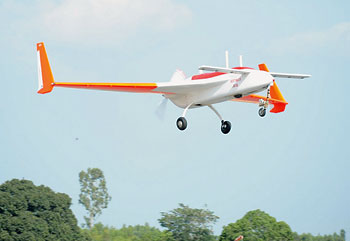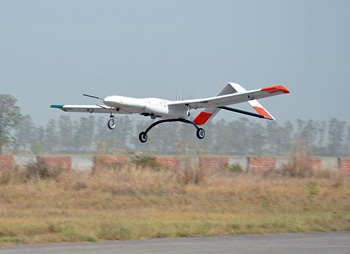INDIAN ARMED FORCES CHIEFS ON
OUR RELENTLESS AND FOCUSED PUBLISHING EFFORTS

SP Guide Publications puts forth a well compiled articulation of issues, pursuits and accomplishments of the Indian Army, over the years

I am confident that SP Guide Publications would continue to inform, inspire and influence.

My compliments to SP Guide Publications for informative and credible reportage on contemporary aerospace issues over the past six decades.
- Prime Minister witnesses 'Bharat Shakti' – a Tri-Services Firing and Manoeuvre Exercise in Pokhran, Rajasthan
- Interim Defence Budget 2024-25 — An Analysis
- Union Defence budget 2024
- Prime Minister Modi Commemorates Indian Navy Day in a Grand Ceremony
- Prime Minister Modi Flies in the LCA Tejas
- New Chapter in India-Italy Defence Ties
- Airpower beyond Boundaries
Unmanned: The Future of Air Wars


If even a fraction of work being done right now – both in terms of procurement as well as development – comes to timely fruition, India will be on course to deploying a robust and advanced arsenal of unmanned systems in all dimensions. The scope of work being done in unmanned air systems (UAS) is particularly ambitious. India currently has a large number of parallel development programmes, some in advanced stages, and some still in very preliminary concept phases. Without exception, they are each complex, game-changing technologies that will catapult the armed forces into the next generation of both defensive and offensive capabilities, deterrence and power projection. One thing seems certain – while India has so far been a buyer of unmanned air systems from abroad (its arsenal is dominated by Israel-built Heron, Searcher Mk.2 surveillance drones and Harop self-destructing UCAVs), the armed forces are no longer interested in being simply importers of equipment from foreign vendors (though there are several such opportunities too – a tri-service requirement for high altitude long endurance UAS, an Indian Air Force (IAF) requirement—albeit stalled—for UCAVs and the Indian Navy’s search for shipborne unmanned helicopters and medium altitude long range (MALE) maritime UAS). The sentiment has compelled a change of tact, and the future mantra is undoubtedly co-development, joint manufacturing, joint marketing, joint ownership. Any company simply looking to sell a few UAS to the Indian Government now with no strings attached is perhaps looking at things from a 1980s perspective when India had no choice but to buy these systems from abroad. In the event, the opportunities that currently exist for cooperation in the unmanned space are plentiful and potentially long-term. The fact that many of these programmes are still on the drawing board offers experienced technology houses abroad the opportunities to pitch in, share technologies and help speed Indian programmes along, providing a win-win situation for all concerned, not least the armed forces which require systems quickly and on cost.
Take, for instance, the least known of India’s unmanned programmes: the recently revealed Indian Unmanned Strike Air Vehicle (IUSAV). The flying wing pilotless strike aircraft project is more complex, ambitious, and potentially expensive than anything India currently has on the table (or off – the IUSAV is still a classified programme, though the Defence Research and Development Organisation (DRDO) and the Ministry of Defence (MoD) now acknowledge its existence since the programme is almost certain to require frequent budgetary and technology support). Very little is known or revealed about the IUSAV, though public domain reports suggest that it will be a futuristic aircraft similar in shape to the multi-nation European Neuron platform that made its first flight three months ago. The Aeronautical Development Establishment (ADE), the nodal DRDO laboratory conceptualising the IUSAV, is currently working on a timeframe of 2020 by which time it hopes to have the platform operational and proven. Seven years may seem like a healthy amount of time, but for a system as complex as an unmanned strike aircraft, the hurdles are large and plentiful. The IUSAV will incorporate largely ab initio technologies including its flying wing design, flying wing controls, radar absorbent paint, serpentine intake architecture, encrypted datalinks, not to mention modified turbofan engines, sensors and smart weapons. It is known that Dassault Aviation, Saab and BAE Systems have all offered technologies and assistance to the Indian establishment in the development of the IUSAV. Discussions are on at various levels on how the IUSAV can quickly be brough to the prototype and then testing stages. It is also learnt that the beleaguered Kaveri jet engine programme will spin off a modified version to power the IUSAV and that studies in this regard have already been initiated.
The other is the less advanced, though no less ambitious, Rustom-H – a hunter-killer drone concept on the lines of the US-built Predator. The Rustom-H mock-up was displayed for the first time at Aero India 2009, and made a comeback at Aero India 2011, but it remains on ground. Timelines in the programme show that the Rustom-H should take to the air in early 2014, and there are no indications that this won’t happen. It has also been revealed that the ADE is producing 10 such systems at a cost of about $350 million already. A large amount of ab initio development in the Rustom-H programme will in fact flow directly into the exponentially more advanced IUSAV project, including data-links, sensors and weapons (in 2011, it was revealed that the DRDO was developing an extended range version of the HELINA anti-armour missile specifically for the Rustom-H and other airborne platforms). So far, the only progress in the Rustom programme has been the Rustom-1 that continues to be tested as a tactical surveillance drone. At this stage, it is not clear what engines will power the twinengined Rustom-H. The platform’s official mission requirements include reconnaissance and surveillance, damage assessment, laser designation, strike, long endurance at high altitude, SAR/MPR missions, EO/LREO missions, waypoint navigation, etc.
The only indigenous unmanned air system currently near service with the Indian military is the Nishant – after confirmatory trials, the surveillance UAV is ready for operations with the Indian Army, and will be inducted shortly. Highlighting other achievements in unmanned systems in the indigenous space, the Ministry of Defence notes, “Orders for Lakshya II pilotless target aircraft capable of flying in sea skimming mode and tree top heights are expected from the services after successful demonstration to them (flying at sea skimming height of about 15 metres at DRDO’s test range near Balasore, Lakshya-II the advanced version of DRDO’s pilotless target aircraft today demonstrated its full capability in January last year). Similarly, UAV Rustom-I, a forerunner to MALE UAV Rustom-2, had series of successful trials. Indigenously designed and developed RUSTOM-1 underwent series of successful test flights. This UAV has the potential to be used for military missions like reconnaissance, surveillance, target acquisition, target designation, communications relay, battle damage assessment and signal intelligence. A mini UAV - NETRA, especially suited for low intensity conflict operations was inducted by the Central Reserve Police Force (CRPF). NETRA has four high speed propellers allowing it to take off and land vertically. Similarly a fixed wing mini UAV for low intensity conflict was demonstrated to security forces at various locations for surveillance within the range of 10 kms. It is also useful in reconnaissance over hills.”
At Aero India 2011, the National Aerospace Laboratory (NAL) revealed the SlyBird micro-air vehicle (MAV). In September last year, India’s National Programme on Micro Air Vehicle (NPMICAV), a Department of Science and DRDO joint effort, announced a countrywide competition MICAV2013 organised by NAL and Aeronautical Development Establishment (ADE) where national labs, companies and industry, and students would build micro-air vehicles and demonstrate their capabilities. According to NAL, the competition seeks to “bring out the capability of vehicles and technologies being developed in the country for performing a defined mission using multiple MICAVs (fixed-wing, rotary-wing, flapping-wing and combinations) and unmanned ground vehicles (UGVs).” It goes on to add that the objective of NPMICAV is to indigenously develop MIC technologies at sub-system as well as system level. “These vehicles are meant to address a large number of civilian and military applications including search and rescue, disaster management, traffic monitoring and management, remote sensing, terrain mapping, etc.” The focus and thrust areas for the competing MAVs will be communication, precise navigation, sensor capabilities, video transmission, multi-vehicle coordination, cooperative flying and vision based manual flying through windows. The requirement for such systems is large – across the military, paramilitary and police services across the country.
Companies like Lockheed Martin have tapped the unmanned space at the grassroots. It provides engineering and funding support to the Delhi Tech University in building the Arush X1 prototype surveillance UAV (which flew for the first time in December 2011), with plans now to expand the platform’s capabilities. Other companies like EADS, Saab, BAE Systems, even MiG, are looking to forge partnerships with Indian firms, academia and institutions to build future unmanned platforms for a variety of missions. The Indian private sector has emerged in a big and promising way when it comes to innovations in the unmanned space. Companies have shown alacrity in investing their own money in R&D to produce systems that could, with help and support from industry and the military/government, go on to become robust military systems in operation with the armed forces. Private firms are constantly on the lookout for tie-ups with experienced foreign technology houses for systems across the board – entire UAS to engines, optics, electronics, avionics, communications, sensors etc. There is cooperation between government agencies and the private sector too. In May last year, private firm Kadet Defence Systems revealed that it has entered into an agreement with NAL to produce an optionally unmanned version of the Hansa basic trainer/aerobatics aircraft. Several other such opportunities could potentially exist.
Companies seeking to do business in the UAS space should know that the door is wide open, but only long-term engagements that accrue benefits to the Indian military-industrial complex. The days of a buyer-seller relationship are over. But a healthy market remains, and remains oriented towards furustic systems development.





